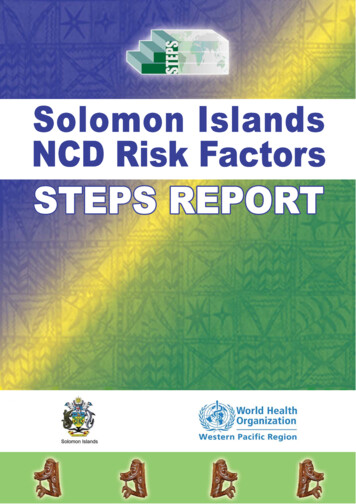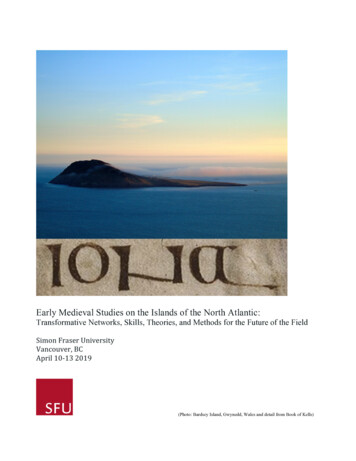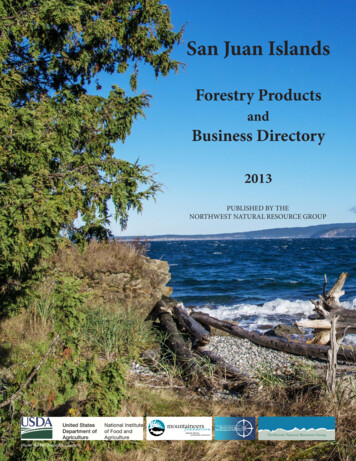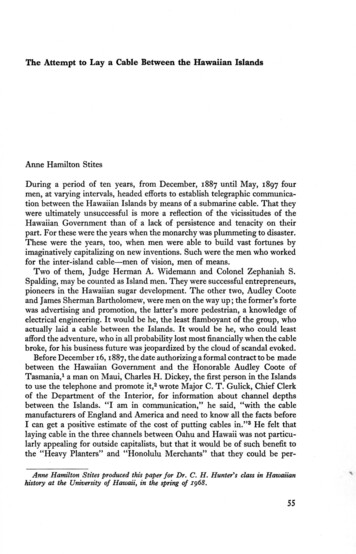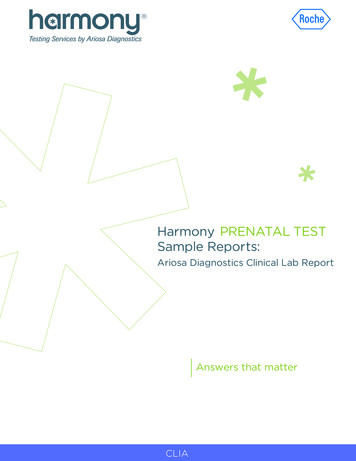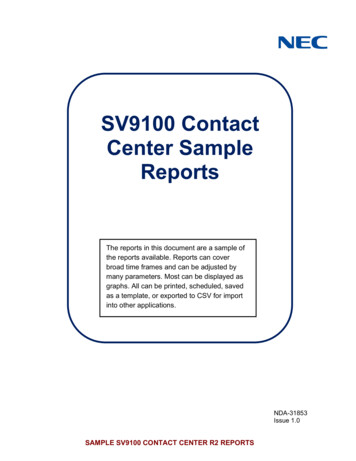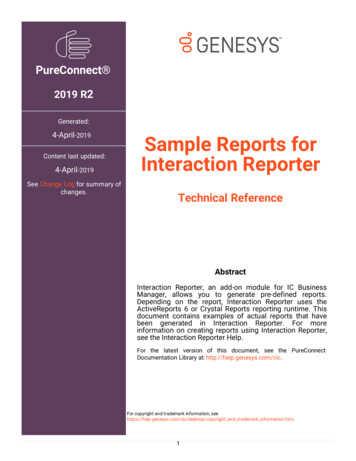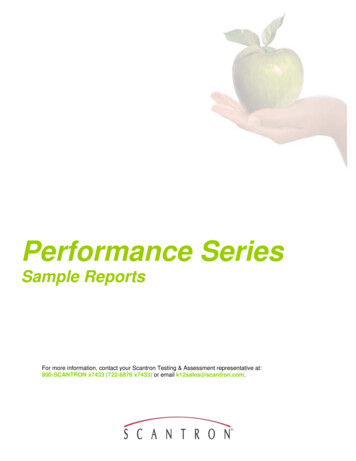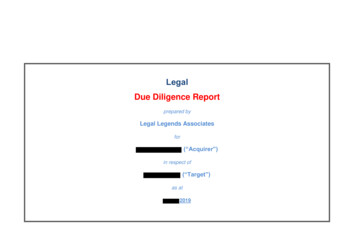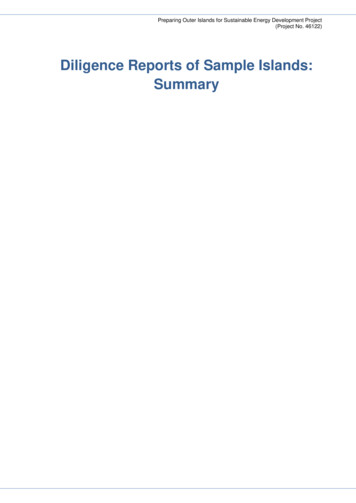
Transcription
Preparing Outer Islands for Sustainable Energy Development Project(Project No. 46122)Diligence Reports of Sample Islands:Summary
Preparing Outer Islands for Sustainable Energy Development Project(Project No. 46122)Table of Contents1 Methodology and Case Studies .31.1.Methodology for the MiniGrid Islands Design .31.2.Case Study 1: S. Addu .51.3.Case Study 2: Ga. Vilingili .61.4.Case Study 3: Lh. Kurendhoo .71.5.Case Study 4: B. Goidhoo .71.6.Case Study 5: Th. Buruni .92 Summary of the Roadmap . 102.1.MAIN RESULTS FROM THE ROADMAP . 103 Replacement of batteries . 113.1.Example of Li-ion battery recycling process . 113.2.Grouping . 113.3.Selecting the right recyclers . 113.4.Recycling the battery modules . 114 Grid Integration Issues . 135 STABILITY ANALYSIS . 165.1.MAIN CONSIDERATIONS AND SCOPE . 165.1.1.Frequency Stability . 165.1.2.Methodology Used. 165.2.DESCRIPTION OF THE MODELS USED . 175.2.1.Diesel generator set model . 175.2.2.PV plant model . 185.2.3.Storage system . 215.2.4.Voltage Source Converter . 215.2.5.Load . 215.3.SUMMARY OF THE RESULTS . 23
Preparing Outer Islands for Sustainable Energy Development Project(Project No. 46122)1 METHODOLOGY AND CASE STUDIES1.1.METHODOLOGY FOR THE MINIGRID ISLANDS DESIGN1.For the purpose of this analysis, the islands outside the greater Male’ region arereferred to as the outer islands. Electricity services for islands in the Greater Male’ region areprovided by STELCO while FENAKA covers the remaining islands. Out of a total of the 194inhabited islands in the Maldives, power systems on 162 FENAKA and STELCO islands1were analysed on an island-by-island basis, regarding their electricity production andconsumption, installed generation capacities, and associated costs. For A two-step approachwas followed with the first step the selection of 5 sample islands in 2013 that wereconsidered generally representative of the islands in the Maldives. Detailed technicalanalysis including resource mapping, power system analysis and system modelling and duediligence of the site was carried out. In the second step, the systems designed for the 5islands were extrapolated to cover the remaining 157 islands. For the technical design, threeconceptual models with different modes of operation based on the proportion of renewableenergy penetration (RE %) were developed for the project. These three models are given inTable 1.Table 1: Three models with different levels of renewable energy penetrationType A: Moderate renewable energypenetration(REpenetration up to 10 % in energy terms) Type B: High renewable energy penetration (10% RE penetrationto 80% in energy terms) 1For Type A islands, the proportion of renewable energy is upto about 10% in energy terms on an annual basis.The power systems on these islands absorb and utilizerenewable energy as available. While renewable energycontributes during periods of high solar or wind availability, theshare of diesel based power remains significant even at thosetimes.This moderate level of renewable energy penetration leveldoes not require the installation of battery storage systems.However, these systems would need to be backed up withautomatic generator controllers and take advantage of anyflexible loads that can be re-scheduled.The islands chosen for Type A usually correspond to largeelectricity consuming islands with efficient levels of operation.Type A is an intermediary step to transitioning 100% dieseldependent islands to Type B islands.For Type B islands, the proportion of renewable energy isbetween 10% and 80% on energy terms on an annual basis.For these islands, a battery storage system is designed toprovide grid support and can be used as a backup system toovercome cloud-shading effects in the PV panels and otherintermittency issues associated with renewable energysystems.Existing generators may not supply enough inertia to thesystem when outages or abrupt changes in the output ofrenewable energy occur leading to instantaneous fluctuationsin frequency and causing system instability.The existing control devices in the system are usually unableto follow abrupt changes and countermeasures includingdemand side management and batteries (such as lithium ionbatteries) are proposed as grid support for these islands.Electricity services on the remaining islands are provided by individual island development councils with significant support in forms ofcapital investment from the Government. Lack of professionally qualified operators and spares has over time resulted in a decline in servicequality and the electricity systems on these islands are gradually being absorbed by the utility companies e.g. FENAKA.
Preparing Outer Islands for Sustainable Energy Development Project(Project No. 46122) The islands chosen for Type B correspond to medium levels ofpopulation and electricity consumption. Type C: Full RE penetration (RE penetration higher than 80%): For Type C islands with full RE energy penetration, practicallyall energy consumed by energy customers would be sourcedfrom renewable energy generation plants on an annual basis.The energy storage is designed and sized in this case forpower stability support as well as energy support in case oflong periods of lack of solar or wind energy.This type of micro-grids is dominated by batteryinverter/charger although, sometimes, diesel backup isinstalled for security reasons for supply security in case offailure or maintenance.The islands chosen for Type C correspond to low population,low volumes of electricity consumption and very high cost ofelectricity and very high levels of subsidies.2.The methodology, used in this study to recommend the least cost approach forintegrating the required contribution of renewable energy into the grid system, is as follows: A reference scenario for projected diesel use, under a business as usual scenario, isestablished, taking into account the projected load forecast including future increasesin demand. Different load forecasts are defined for each of the proposed Types. The estimated reduction in diesel use with the proposed RE interventions against thereference scenario, is established. Land and roof-top availability constraints are considered for maximum REpenetration. Renewable energy options (solar energy and wind energy) considered potentiallyviable on an island by island solution, are explored in detail with regards to theirresource potential, technical feasibility and cost. Several simulations are alsoprepared for optimal penetration over an atoll-wise approach. The Software Homer isused at this stage to arrive at the optimal solution. A simulation model is run to calculate the limits of intermittent renewable energypenetration and to determine grid compatibility. The size of the battery storagesystem is pre-designed when necessary (For Type B and C). According to each island classification (A, B, C), the generation mix in order toachieve the optimal RE system penetration is calculated. Different financing arrangementssustainability of the project.3.aremodelledtodeterminethe financialThis methodology has enabled an understanding of: the renewable energy options which are available to Maldives, given both thecountry’s resource potential and particular grid characteristics; the amount of renewable energy required to be generated according to Type A, B andC classification, and the cost and financial implications the selected renewable energy scenarios.4.Given an understanding of the above, a least cost approach for integrating therequired contribution of renewable energy into the grid is recommended and presented. Themodelling outputs for the 5 sample islands are provided below.
Preparing Outer Islands for Sustainable Energy Development Project(Project No. 46122)1.2.CASE STUDY 1: S. ADDUAtoll. Island:S. AdduCurrent situation:Installed generation capacity (kW)PopulationMeasured peak (kW)Energy consumption (MWh/day)Specific fuel consumption 00960.29026,744,095Proposed Hybrid ,208emissionsDaily Profile4,000Load (kW)Photovoltaic (kWp)Total diesel (kW)Generator 1 (kW)Generator 2 (kW)Generator 3 (kW)Generator 4 (kW)Generator 5 (kW)Generator 6 (kW)Generator 7 (kW)Batteries (kWh)Battery inverters (kW)RES penetration 4Estimated/Current Daily ProfileMonthly Average Electric setGenset4,000Power AugSepOctNovDecCommentsAll currently installed generators may continue in operation since their specific fuelconsumption is acceptable. A Type A configuration is initially proposed and a transition toType B can be considered at a subsequent stage.2The CO2emissions have been estimated taking into account the expected demand growth.
Preparing Outer Islands for Sustainable Energy Development Project(Project No. 46122)1.3.CASE STUDY 2: GA. VILINGILIAtoll. Island: Gaaf Alif. VilingiliCurrent situation:800Installed generation capacity (kW)4264Population768Measured peak (kW)12Energy consumption (MWh/day)0.324Specific fuel consumption (L/kWh)Estimated CO2 emissions (kg/year)33,623,312Proposed Hybrid System30080050030078.020011.22,882,627Lithium-ion batteries (kWh)Battery inverters (kW)RES penetration (%)EstimatedCO2emissions1(kg/year)Daily Profile500Load (kW)Photovoltaic (kWp)Total diesel (kW)Generator 1 (kW)Generator 2 (kW)40030020010000612Hour1824Estimated/Current Daily ProfileMonthly Average Electric Production500PVGenset 1Genset 2Power DecCommentsIt is proposed that all currently installed generators be replaced by new ones because theisland’s specific fuel consumption is excessive. A Type B configuration is proposed.3The CO2 emissions have been estimated taking into account the expected demand growth.
Preparing Outer Islands for Sustainable Energy Development Project(Project No. 46122)1.4.CASE STUDY 3: LH. KURENDHOOAtoll. Island: Lhaviyani. KurendhooCurrent situation:Installed generation capacity (kW)PopulationMeasured peak (kW)Energy consumption (MWh/day)Specific fuel consumption 40.4001,300,472Proposed Hybrid System30025410415078.030034.9633,030Lead-acid batteries (kWh)Battery inverters (kW)RES penetration (%)Estimated CO2 emissions1(kg/year)Daily Profile200Load (kW)Photovoltaic (kWp)Total diesel (kW)Generator 1 (kW)Generator 2 (kW)1501005000612Hour1824Estimated/Current Daily ProfileMonthly Average Electric Production160PVGenset 1Genset 2Power mmentsIt is proposed that the currently installed generators be replaced by new generators, becausetheir specific fuel consumption is excessive. A Type B configuration is proposed.1.5.4CASE STUDY 4: B. GOIDHOOThe CO2 emissions have been estimated taking into account the expected demand growth.
Preparing Outer Islands for Sustainable Energy Development Project(Project No. 46122)Atoll. Island: Baa. GoidhooCurrent situation:Installed generation capacity (kW)PopulationMeasured peak (kW)Energy consumption (MWh/day)Specific fuel consumption (L/kWh)5Estimated CO2 emissions (kg/year)1287381091.80.400674,904Proposed Hybrid System78.020037.5423,175Daily Profile100Load (kW)200160160Photovoltaic (kWp)Total diesel (kW)Generator 1 (kW)Generator 2 (kW)Generator 3 (kW)Lead-acid batteries (kWh)Battery inverters (kW)RES pe
was followed with the first step the selection of 5 sample islands in 2013 t hat were considered generally representative of the islands in the Maldives. Detailed

